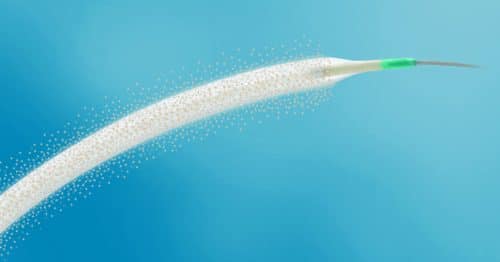Clinical studies prove the effectiveness and safety of combined treatment for peripheral artery disease, which includes treatment with Passeo-18 Lux together with Pulsar-18 - both from Biotronic

Biotronic, a developer and manufacturer of medical devices for the treatment of heart diseases, presented during the LINC 2016 conference the results of the BIOLUX P-III study that referred to the effectiveness of the use of Passeo-18 Lux, the company's drug-releasing balloon (DRB). 700 peripheral artery disease patients from 55 sites in 19 countries took part in the study. The Passeo-18 Lux enables optimal transfer of the drug directly to the target tissue. Another unique feature of the balloon is its protective auxiliary envelope that helps in more efficient targeting.
"Passeo-18 Lux has already proven its safety in a number of controlled trials in the past both in cases of superficial femoral artery (SFA) and in cases of below-the-knee (BTK)," says Dr. Gunnar Tepe, from the Rosenheim clinic in Germany. "The current study extended the use to a wide population that would reflect the treatment as a routine medical procedure. The results of the study support the fact that the treatment is effective for the treatment of arterial blockages in the lower limbs.' According to Dr. Tapa, the current study confirms the results obtained from a series of smaller studies, while supporting it
in drug-coated balloon (DCB) as a potential standard approach for the treatment of lower extremity diseases.
The primary endpoint of the BIOLUX P-III study was freedom from severe adverse events (MAE) at 6 months, defined as death, amputation, and re-catheterization of the area (TLR). Of the 200 patients for whom the data was collected, the rate of patients who did not have severe adverse effects (MAE) was 94.4% and the rate of patients who did not require repeat catheterization in the area was 96.8%.
In additional studies, BIOFLEX PEACE and BIOLUX 4EVER, the effectiveness and safety of a combined treatment course in peripheral artery disease was demonstrated, using the Passeo-18 Lux, a drug-releasing balloon (DRB) and the Pulsar-18, an innovative stent - both from Biotronic. The Pulsar-18 stent, which has a flexible design that incorporates proBIO silicone coating into the stent, which significantly optimizes its compatibility with the patient's body. It combines a flexible design with thin struts and the ProBio coating significantly improves its biological compatibility in the patient's body, which contributes to the excellent clinical results in studies.
"Both studies reinforce what we already knew from previous studies, such as DEBAS: the combination of the two products contributes to improving patient treatment outcomes," says Dr. Mariana Brodman, from the University of Graz in Austria and director of the LINC 2016 conference.
Peripheral artery disease, or peripheral vascular disease, is a disease caused by blockages of arteries that carry blood to the limbs, especially the lower limbs (legs). This disease is one of the reasons for the increase in the rate of heart disease and mortality in the population. The blockage of the arteries can occur anywhere in the arterial pathway in the circulatory system: first from the aorta artery (aorta) to the small blood vessels in the feet. The symptoms of the arterial disease can be in the form of complaints of lack of pulse in the legs or in the form of necrosis and irreversible wounds. This disease is found in a fifth of the population over the age of 70.
